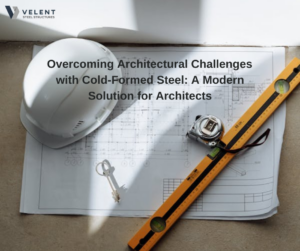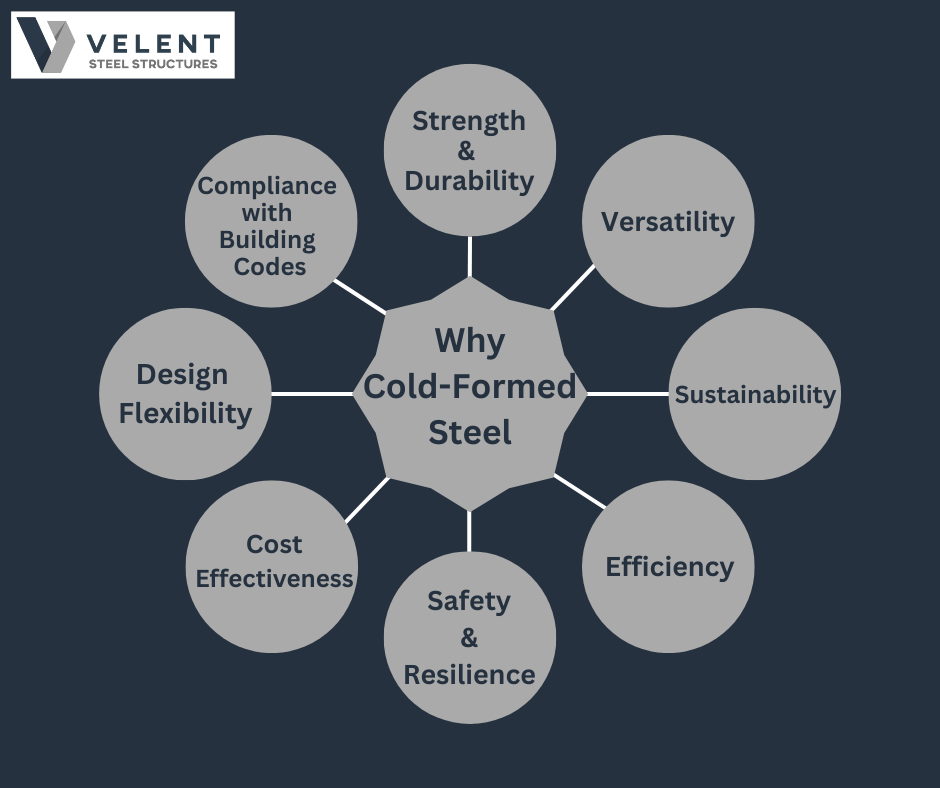As the demands of modern architecture grow increasingly complex, architects are continually seeking materials that balance form, function, and sustainability. Cold-Formed Steel (CFS) has emerged as a versatile and reliable solution for addressing many of the design challenges architects face today. From supporting intricate designs to ensuring sustainability and cost-efficiency, CFS is redefining the possibilities of modern construction. In this blog, we explore how CFS meets and exceeds the expectations of architects around the globe.

Understanding the Role of CFS in Architecture
Cold-Formed Steel is made by rolling thin sheets of steel at room temperature to create lightweight yet highly durable structural components. Its exceptional strength-to-weight ratio and adaptability make it a favorite among architects looking to balance aesthetics with structural integrity.
Key Attributes of CFS
- Lightweight Design: Reduces the load on foundations and simplifies transportation.
- Precision Manufacturing: Ensures uniformity and consistency for high-performance applications.
- Customizability: Allows for intricate and unconventional architectural designs.
How CFS Solves Architectural Challenges
a) Design Flexibility for Complex Structures
Architects often face challenges when designing buildings with unique or intricate shapes. Traditional materials like wood and concrete can limit design possibilities due to their rigidity and weight. CFS, on the other hand, offers unparalleled flexibility, enabling:
- Creative and open layouts without compromising structural integrity.
- Curved and angular designs through custom fabrication techniques.
- Seamless integration with other materials, such as glass and aluminum.
Example: A commercial skyscraper in Dubai utilized CFS framing to achieve its fluid, wave-like façade, which would have been difficult and cost-prohibitive with heavier materials like concrete.
b) Sustainability and Green Building Standards
With the rise of green construction practices, architects are under pressure to reduce the carbon footprint of their designs. CFS supports sustainability in several ways:
- 100% Recyclable: Steel can be reused without loss of quality, minimizing construction waste.
- Energy Efficiency: Prefabricated components reduce on-site energy consumption during assembly.
- Longevity: Resistant to corrosion, termites, and rot, CFS structures require less maintenance, reducing the need for frequent repairs.
Key Fact: According to the Steel Recycling Institute, steel is North America’s most recycled material, with an overall recycling rate of 90%.
c) Streamlining Construction Timelines
Time constraints are a common challenge in architecture. CFS’s prefabrication capabilities allow architects to:
- Accelerate project timelines with ready-to-install components.
- Minimize weather-related delays, as most of the assembly occurs off-site.
- Ensure precision, reducing errors and rework during installation.
Case Study: A housing project in Seattle reduced its construction time by 30% using prefabricated CFS panels, allowing developers to meet tight deadlines without compromising quality.
d) Addressing Building Code Requirements
Navigating building codes and safety regulations can be challenging for architects. CFS’s inherent properties make compliance easier:
- Non-combustible material ensures fire resistance, meeting stringent fire safety codes.
- High seismic performance makes it ideal for earthquake-prone regions.
- Resistance to moisture and pests ensures durability in various climates.
Example: In California, where stringent seismic codes are in place, Cold-Formed Steel has become a preferred choice for ensuring compliance. A residential project in Los Angeles utilized CFS framing to meet rigorous earthquake resistance standards, reducing structural vulnerabilities while maintaining design flexibility. The project not only passed inspections seamlessly but also set a benchmark for sustainable and resilient construction in seismic zones.
Innovative Uses of CFS Across Industries
a) Commercial Buildings
From high-rise office towers to shopping malls, CFS provides the strength and adaptability needed for large-scale projects. Its lightweight nature reduces the load on foundations, making it an economical choice for multi-story structures.
b) Residential Projects
CFS is gaining popularity in residential construction, particularly for:
- Modular housing, where precision and speed are critical.
- Multi-family units that require soundproofing and fire-resistant materials.
c) Renovation and Retrofitting
In renovation projects, where weight and space constraints are common, CFS’s lightweight and customizable nature makes it an ideal choice for adding new elements without overburdening existing structures.
Emerging Trends in CFS for Architects
a) Integration with Smart Building Technologies
CFS is increasingly being used in smart buildings, where precision and adaptability are crucial for integrating advanced technologies such as automated systems and energy-efficient solutions.
b) 3D Printing and Advanced Fabrication
Innovations in manufacturing are enabling architects to leverage CFS for 3D-printed components, allowing for even greater design freedom and accuracy.
c) Increased Use in Sustainable Urban Development
As urban areas continue to grow, CFS is playing a pivotal role in creating sustainable, high-density housing that balances environmental concerns with the need for durable and cost-effective materials.
Conclusion: Why Architects Should Embrace CFS
Cold-Formed Steel isn’t just a building material—it’s a game-changer for modern architecture. Its ability to adapt to complex designs, meet sustainability goals, and streamline construction processes makes it an indispensable tool in any architect’s arsenal. Imagine designing with a material that gives you the freedom to dream big while meeting practical challenges like sustainability, safety, and efficiency.
Whether you’re designing a sleek commercial tower, a sustainable residential community, or a cutting-edge renovation project, CFS has the versatility and performance to bring your vision to life.
Why settle for conventional when you can build smarter and stronger? Explore how Cold-Formed Steel can redefine your next project. Contact us for tailored solutions and expert guidance that align with your architectural ambitions.


